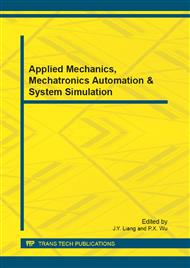[1]
Y. Lin, F. He, Principle and Application of MIMO Technology, Beijing, China: Posts & Telecom Press, (2010).
Google Scholar
[2]
A. Song, M. Badiey, and V. K. McDonald, Multi-channel combining and equalization for underwater acoustic MIMO channels, in Proceedings of the MTS-IEEE Oceans Conference, Quebec, Canada, September2008.
DOI: 10.1109/oceans.2008.5152115
Google Scholar
[3]
B. Li, S. Zhou, M. Stojanovic, et al, MIMO-OFDM over an underwater acoustic channel, in Proceedings of the MTS-IEEE Oceans Conference, Vancouver, Canada, October (2007).
DOI: 10.1109/oceans.2007.4449296
Google Scholar
[4]
B. Li, S. Zhou, et al, MIMO-OFDM for high rate underwater acoustic communications, IEEE Journal of Oceanic Engineering, vol. 34, no. 4, p.634–644, (2009).
DOI: 10.1109/joe.2009.2032005
Google Scholar
[5]
D. L. Donoho, Compressed sensing, IEEE Transactions on Information Theory, vol. 52, no. 4, p.1289–1306, (2006).
DOI: 10.1109/tit.2006.871582
Google Scholar
[6]
C. R. Berger, S. Zhou, J. C. Preisig , and P. Willett, Sparse channel estimation for Multicarrier underwater acoustic communication: from subspace methods to compressed sensing, IEEE Transactions on Signal Processing, vol. 58, no. 3, p.1708–1721, (2010).
DOI: 10.1109/tsp.2009.2038424
Google Scholar
[7]
J. Huang, J. Huang, and G.R. Berger, Iterative sparse channel estimation and decoding for underwater MIMO-OFDM, IEEE Transl. J. Magn. USA, vol. 2010, p.11, October (2010).
DOI: 10.23919/oceans.2009.5422203
Google Scholar
[8]
S. Roy, T. M. Duman, V. McDonald, and J. G. Proakis, High-rate communication for underwater acoustic channels using multiple transmitters and space-time coding: receiver structures and experimental results, IEEE Journal of Oceanic Engineering, vol. 32, no. 3, p.663–688, (2007).
DOI: 10.1109/joe.2007.899275
Google Scholar
[9]
A. T. Figueiredo, R. D. Nowak, and S. J. Wright, Gradient projection for sparse reconstruction: application to compressed sensing and other inverse problems, IEEE Journal of selected topics in signal processing, vol. 1, no. 4, p.586–596, (2007).
DOI: 10.1109/jstsp.2007.910281
Google Scholar


